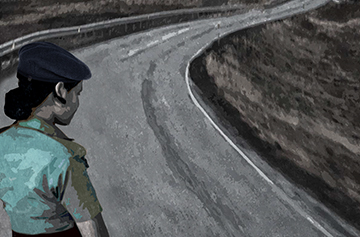A few steps onto the Rough Roads to Equality: Women Police in Bangladesh by Cheryl Blake

In April 2014, over 200 female police personnel from across Bangladesh participated in workshops hosted by the Bangladesh Police Women’s Network (BPWN) and the Commonwealth Human Rights Initiative (CHRI). In these workshops, they revealed details about their experiences to identify some of the barriers women face in the Bangladesh police force, as well as ideas and best practices to help achieve gender equality. This rich information served as the basis for a report on women in policing in Bangladesh, entitled Rough Roads to Equality: Women Police in Bangladesh, building on CHRI’s recent report on the status of women in policing across South Asia.
The Government of Bangladesh has taken a number of progressive steps to support women in policing, many of which have been facilitated by partnership between the Bangladesh Police and the Police Reform Programme (PRP), an initiative of the United Nations Development Programme (UNDP) that began in 2006. Concrete efforts began in earnest under the Bangladesh Police’s Strategic Plan for 2008-2010, which articulated “gender neutrality” as a core value. The Plan set out a number of objectives to foster gender equality in policing. Among these were targets for increasing the number of women on the force, drafting an internal policy on gender equality, and developing gender sensitization training. Additionally, the Plan identified the need for institutionalised support mechanisms for women such as the Bangladesh Police Women’s Network (BPWN).
Obstacles still remain, some of which are rooted in historical bias against women in policing. In the late 1980s, five women joined the upper ranks, or cadre, of the Bangladesh Police after passing the national civil service exam. Almost immediately, they faced a strong backlash. Major General Mahmudul Hasan—the Minister of Home Affairs for Bangladesh’s then-military government—recommended suspending the recruitment of women at the cadre level. Though there were allegedly finding that female cadre officers were not fit for duty, no details have ever been made public.
Even though the military regime led by General Ershad ended one year after cadre-level recruitment of women was suspended, this freeze persisted for a full ten years, until Sheikh Hasina became Prime Minister in 1998. Since then, there has been a steady rise of women in the cadre ranks. Still, these ten lost years have left their mark. It comes as no surprise that only one woman currently holds the second highest rank in the Bangladesh Police.
Other obstacles are very much rooted in present circumstances, ranging from limited resources and infrastructure to experiences of outright gender bias. Our workshops uncovered inconsistent access to separate toilets and break rooms for women in police stations. Further, the lack of separate barracks for women limits where they can be posted, which in turn can affect their career opportunities.
The women we spoke to also underscored the need for greater support of women’s career development. A number of participants emphasized the need for women to be assigned to investigate sensitive and complex cases, in order to build their skills on par with their male colleagues.
Another barrier facing women is the need to balance work and family. Two thirds of female personnel who participated in our workshops reported working more than eight hours a day. Culturally, women are expected to be primary care givers in the home, and must therefore balance their personal and professional lives in ways their male colleagues are not expected to.
One clear solution would be to institute a shift system, limiting all police personnel to eight hours of work per day. This is no small task, as the primary reason for shifts exceeding eight hours (or even twelve hours) is due to the lack of police personnel. Yet, this also provides the opportunity for the Bangladesh Police to push for greater funding and recruitment. Indeed, the department can seize this as a chance to further increase the number of women serving on the police force by recruiting women to fill the positions needed to make eight hour work shifts feasible.
Recommendations such as this one—and many more—can come out of looking closely at the experiences of police on the ground. The ideas, concerns, and knowledge of police personnel themselves help the department know how to target its resources to advance gender equality in the police force. It is hoped that this report will serve as a starting point for such initiatives.
To learn more, contact Aditi Datta at aditi@humanrightsinitiative.